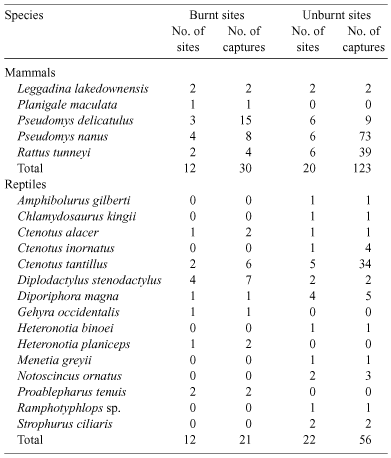The short-term effects of an extensive and high-intensity fire on vertebrates in the tropical savannas of the central Kimberley, northern Australia
Sarah Legge A C D , Stephen Murphy A , Joanne Heathcote A , Emma Flaxman A , John Augusteyn B and Marnie Crossman BA Australian Wildlife Conservancy, Mornington Wildlife Sanctuary, PMB 925, Derby, WA 6728, Australia.
B Queensland Parks and Wildlife Service, PO Box 3130, North Rockhampton, Qld 4701, Australia.
C Australian National University, Canberra, ACT 0200, Australia.
D Corresponding author. Email: sarah@australianwildlife.org
Wildlife Research 35(1) 33-43 https://doi.org/10.1071/WR07016
Submitted: 9 February 2007 Accepted: 23 January 2008 Published: 17 March 2008
Abstract
We report the effects of an extensive (>7000 km2), high-intensity late-dry-season fire in the central Kimberley, Western Australia, on the species richness and abundance of mammals, reptiles and birds. Five weeks after the fire we surveyed 12 sites (six burnt, six unburnt); each pair of sites was closely matched for soil type and vegetation. The species richness and abundance of mammals and reptiles was greater at unburnt sites, especially for mammals (with a 4-fold difference in abundance between burnt and unburnt sites). There was an indication that reptiles immigrated into unburnt patches, but mammals did not. There were also species-specific responses to the fire: Rattus tunneyi and Pseudomys nanus were much more abundant in unburnt sites, whereas Pseudomys delicatulus was caught in equal numbers at burnt and unburnt sites. Diurnal reptiles were more abundant at unburnt sites, but nocturnal reptiles were equally common at burnt and unburnt sites. Avian species richness and overall abundance was similar between burnt and unburnt patches, although a few species showed preferences for one state or the other. The overall high trapping success for mammals (18% across all sites; 28% in unburnt patches) contrasts with the well documented mammal collapse in parts of northern Australia and seems paradoxical given that our study area has experienced the same increase in fire frequency and extent that is often blamed for species collapse. However, our study area has fewer pressures from other sources, including grazing by large herbivores, suggesting that the effects of these pressures, and their interaction with fire, may have been underestimated in previous studies.
Acknowledgements
Thanks to Dan Swan and Butch Maher for help with logistics. Alaric Fisher (Tropical Savanna CRC) provided helpful advice on survey design. Constructive comments on the manuscript were gratefully received from John Woinarski, Alan Andersen, Ray Lloyd, Kim Maute, and three reviewers. This study was funded through the generosity of an anonymous supporter of the Australian Wildlife Conservancy.
Begg, R. J , Martin, K. C. , and Price, N. F. (1981). The small mammals of Little Nourlanjie Rock, NT. V. The effects of fire. Australian Wildlife Research 8, 515–527.
| Crossref | GoogleScholarGoogle Scholar |
Firth, R. , Woinarski, J. , and Noske, R. (2006). Home range and den characteristics of the brush-tailed rabbit-rat (Conilurus penicillatus) in the monsoonal tropics of the Northern Territory Wildlife Research 33, 397–407.
| Crossref | GoogleScholarGoogle Scholar |
Letnic, M. (2003). The effects of experimental patch burning and rainfall on small mammals in the Simpson Desert, Queensland. Wildlife Research 30, 547–563.
| Crossref | GoogleScholarGoogle Scholar |
Pardon, L. G. , Brook, B. W. , Griffiths, A. D. , and Braithwaite, R. W. (2003). Determinants of survival for the northern brown bandicoot under a landscape-scale fire experiment. Journal of Animal Ecology 72, 106–115.
| Crossref | GoogleScholarGoogle Scholar |
Williams, M. , Cook, G. , Gill, A. , and Moore, P. (1999). Fire regime, fire intensity and tree survival in a tropical savanna in northern Australia. Australian Journal of Ecology 24, 50–59.
| Crossref | GoogleScholarGoogle Scholar |
Williams, R. J. , Woinarski, J. C. Z. , and Andersen, A. N. (2003b). Fire experiments in northern Australia: contributions to ecological understanding and biodiversity conservation in tropical savannas. International Journal of Wildland Fire 12, 391–402.
| Crossref | GoogleScholarGoogle Scholar |

|

|


